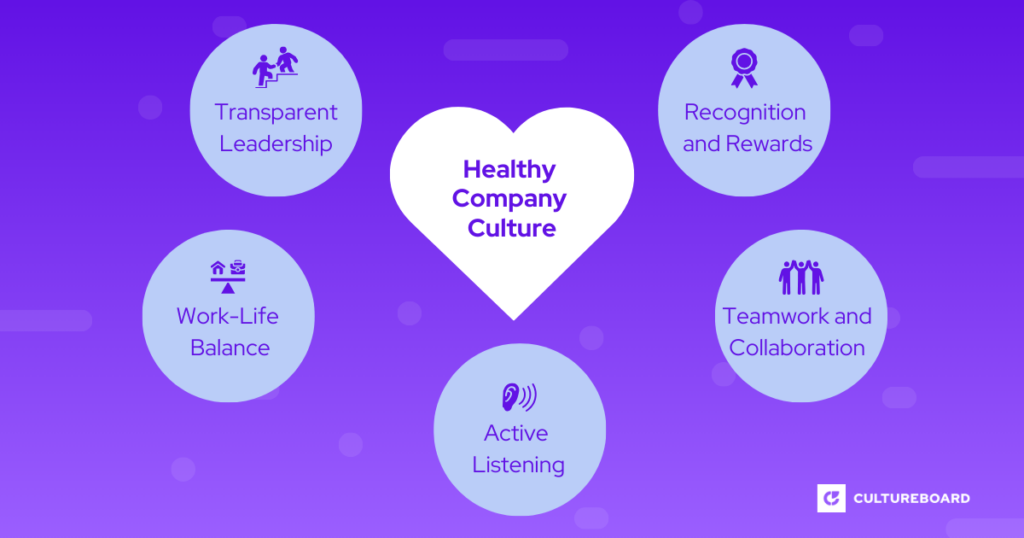Just as any successful recipe requires the right ingredients in the right quantities, a successful business relies heavily on its company culture.
Culture is the organization’s personality, shaping the atmosphere felt upon entering the office or joining a virtual meeting. Company culture encompasses shared values, attitudes, and practices that dictate how work is conducted.
In today’s diverse workforce landscape, with multiple generations present, the importance of company culture has grown exponentially. Millennials and Gen Z employees seek more than just financial compensation. They crave a nurturing work environment where they feel valued and appreciated.
What are the elements of a vibrant Company Culture?
There’s no perfect recipe, but company culture is composed by several essential elements. They act as the pillars of a healthy company culture.
- Vision and Mission: These are the company foundations. They embody the purpose and direction of the organization, creating a sense of meaning and motivation among employees.
- Values: Acting as the organization’s DNA, values define its core beliefs and principles, guiding decision-making and behavior.
- Practices: Values must be translated into action through consistent practices and policies, ensuring alignment between rhetoric and reality. Companies need to, not only do the talk, but also do the walk.
- People: Employees serve as the lifeblood of the organization, contributing to the culture through their actions, attitudes, and interactions.
- Work Environment: Whether physical or virtual, the work environment shapes the backdrop against which the culture unfolds, influencing employee experiences and perceptions.
- Communication: Transparent and respectful communication channels foster trust and collaboration, facilitating the exchange of ideas and feedback.
What’s the impact of a positive Company Culture?
A robust company culture serves as the foundation for employee engagement, productivity, and satisfaction. When employees resonate with the organization’s values and vision, they are motivated to perform at their best, driving organizational success.
Moreover, a positive company culture extends beyond internal dynamics, influencing external perceptions and consumer interactions.
Happy employees tend to share their experiences with others outside the organization, whether by commenting with friends at dinner about how great their work is or praising the company on social networks, such as LinkedIn. There are no better Brand Ambassadors than employees who feel valued.

How to sustain a healthy Company Culture?
Maintaining a thriving company culture requires ongoing effort and commitment from leadership and employees alike.
Here’s a list of key strategies for nurturing and sustaining culture:
Transparent Leadership: Clear communication and visible leadership are essential for fostering trust and alignment with organizational goals.
Recognition and Rewards: Acknowledging and celebrating employee achievements creates a sense of belonging and reinforces desired behaviors. Kudoslink is a helpful tool in this sense. You can use our digital boards to celebrate and recognize important milestones, such as employee birthdays, employee of the month recognitions, quarterly goals achieved, and much more.
Work-Life Balance: Mental health is more important than ever. Prioritizing employee well-being and promoting work-life balance helps prevent burnout and supports long-term engagement. This means not giving your employees a bigger workload than they can do during regular working hours; checking in to see how the work is going and offering help if they need it; promoting breaks and incentivizing them to take vacations and rest, and more.
Teamwork and Collaboration: Encouraging collaboration and teamwork cultivates a sense of camaraderie and collective purpose. It also fosters new perspectives and innovation. Feedbeo is a great tool to use to start the discussion, get input from peers, and extract the best ideas.
Active Listening: Soliciting and acting upon employee feedback demonstrates respect and responsiveness, driving continuous improvement. In this sense, Surveymeme can be a great help to collect feedback and analyze data in a simple way.
Conclusion
By prioritizing these elements, organizations can cultivate a vibrant company culture that serves as a starting point for success. Let’s embark on this journey together, creating a workplace environment where everyone feels valued and empowered to thrive.
With the help of CultureBoard’s modules, you can listen to your team and gather new ideas, make them apart of the conversation, and show them how much you appreciate their work.
